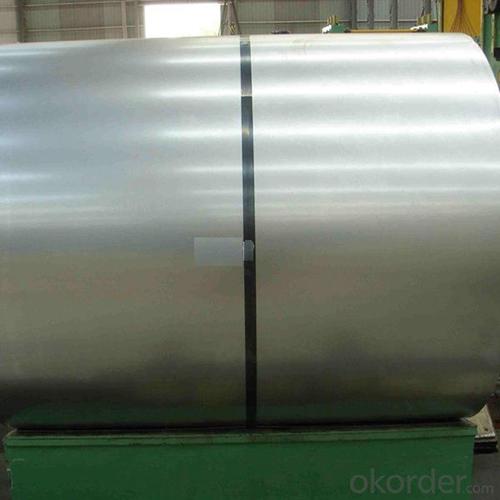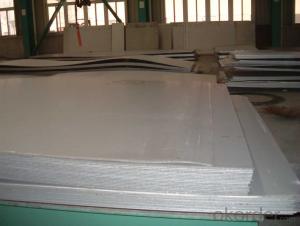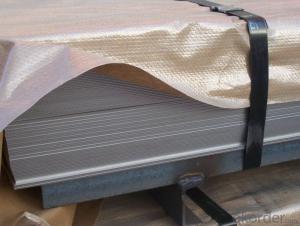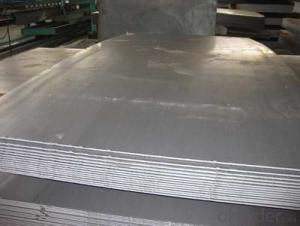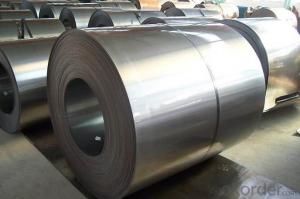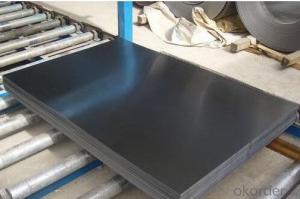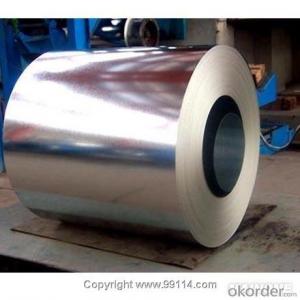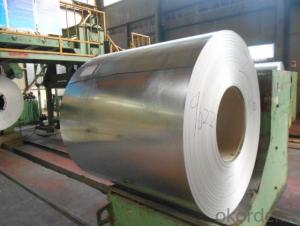Stainless Steel Coil Suppliers Cold Rolled Stainless Steel Coil for Construction Building Materials
- Loading Port:
- Tianjin
- Payment Terms:
- TT OR LC
- Min Order Qty:
- 25 m.t.
- Supply Capability:
- 20000 m.t./month
OKorder Service Pledge
OKorder Financial Service
You Might Also Like
Specification
Specifications for Stainless Steel Coils/Sheets:
Type | 200 series,300 series,400 series |
Thickness | 1.8-8.0mm |
Widthness | 1000/1219/1500mm |
Technique | Hot Rolled/Cold Rolled |
Coil Weight | About 20 Tons |
Finish | NO.1/NO.2B |
Place of Origin | Made in China |
MOQ | 18 ton |
Color | Black,Mirror Finished |
Standard | ASTM, JIS, GB, BS, DIN etc |
Exporting countries | Peru,India,Pakistan,Singpore,Vietnam,South Korea,Malaysia etc. |
After-sales service | Factory Inspection |
Certifications | ISO,SGS |
Packaging | Standard export packing or following customer's demand |
Technical Notes:
Surface Finish | Definition | Application |
2B | Those finished, after cold rolling, by heat treatment, pickling or other equivalent treatment and lastly by cold rolling to given appropriate luster. | Medical equipment, Food industry, Construction material, Kitchen utensils. |
BA | Those processed with bright heat treatment after cold rolling. | Kitchen utensils, Electric equipment, Building construction. |
NO.3 | Those finished by polishing with No.100 to No.120 abrasives specified in JIS R6001. | Kitchen utensils, Building construction. |
NO.4 | Those finished by polishing with No.150 to No.180 abrasives specified in JIS R6001. | Kitchen utensils, Building construction, Medical equipment. |
HL | Those finished polishing so as to give continuous polishing streaks by using abrasive of suitable grain size. | Building Construction. |
NO.1 | The surface finished by heat treatment and pickling or processes corresponding there to after hot rolling. | Chemical tank, pipe |
Specifications for Stainless Steel Coils/Sheets:
Grade | C ≤ | Si ≤ | Mn ≤ | P ≤ | S ≤ | Ni ≤ | Cr ≤ |
201 | 0.12 | 0.75 | 7.00 | 0.045 | 0.045 | 1.00-1.28 | 13.70-15.70 |
202 | 0.15 | 1.00 | 2.25 | 0.045 | 0.045 | 4.07-4.17 | 14.00-16.00 |
304 | 0.08 | 0.75 | 2.00 | 0.045 | 0.03 | 8.00-11.00 | 18.00-20.00 |
304L | 0.035 | 0.75 | 2.00 | 0.045 | 0.03 | 8.00-13.00 | 18.00-20.00 |
309 | 0.15 | 0.75 | 2.00 | 0.045 | 0.03 | 12.00-15.00 | 22.00-24.00 |
310S | 0.08 | 1.50 | 2.00 | 0.045 | 0.03 | 19.00-22.00 | 24.00-26.00 |
316 | 0.08 | 1.00 | 2.00 | 0.045 | 0.03 | 10.00-14.00 | 16.00-18.00 |
316L | 0.035 | 0.75 | 2.00 | 0.045 | 0.03 | 10.00-15.00 | 16.00-18.00 |
321 | 0.04-0.10 | 0.75 | 2.00 | 0.045 | 0.03 | 9.00-13.00 | 17.00-20.00 |
405 | 0.08 | 0.75 | 1.00 | 0.045 | 0.03 | 0.06 | 11.5-13.5 |
409 | 0.089 | 1.00 | 1.00 | 0.045 | 0.05 | 0.06 | 10.50-11.75 |
410 | 0.15 | 0.75 | 1.00 | 0.045 | 0.03 | 0.06 | 11.5-13.5 |
420 | 0.16-0.25 | 1.00 | 1.00 | 0.040 | 0.03 | 0.06 | 12.00-14.00 |
430 | 0.12 | 0.75 | 1.00 | 0.045 | 0.03 | 0.06 | 16.00-18.00 |
Packaging & Delivery for Stainless Steel Coils/Sheets:
Packaging Detail Standard export packing or following customer's demand
Delivery Time: Within 30-40 days after deposit or according to the order quantity
Export Markets for Stainless Steel Coils/Sheets:
Our target market is the international market. Every year we export most of products to countries like India, Pakistan, South Korea, Brazil, Australia, South Africa, Spain, Sri Lanka, Taiwan, Hong Kong, etc.
Detailed Picture for Stainless Steel Coils/Sheets:
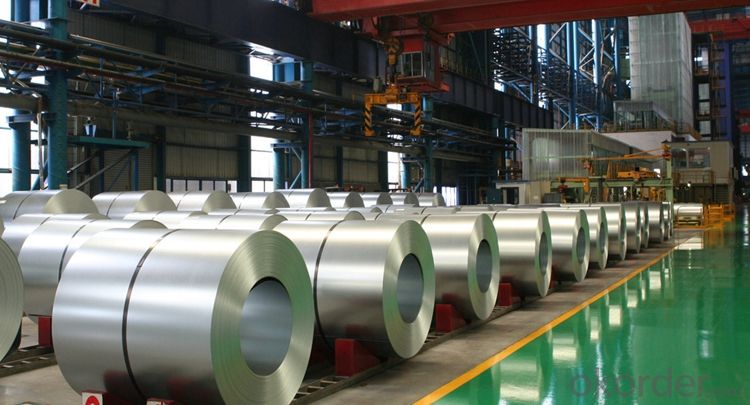
Our Service
1.High quanlity and reasonable price.
2.Customized on-demand.
3.Reasonable shipping and fast delivery.
4.Free sample.
FAQ for Stainless Steel Coils/Sheets:
Q:How to order?
A: Please send us your purchase order by email or fax .or you can ask us to send you a proforma invoice for your order .We need to know the following information for your order.
1) Shipping information-company name, street address, phone number, fax number, destination sea port
2) Product information – Quantity, Specification (steel type, thickness, width, surface finish)
3) Delivery time required
4) Forwarder's contact details if there's any in China
- Q: Are stainless steel sheets suitable for wastewater treatment plants?
- Yes, stainless steel sheets are highly suitable for wastewater treatment plants. Stainless steel is known for its corrosion resistance, durability, and ability to withstand harsh and corrosive environments, making it an ideal material for such applications. It can effectively handle the challenges posed by wastewater treatment plants, including exposure to chemicals, moisture, and high temperatures, while maintaining its structural integrity and preventing contamination.
- Q: Are stainless steel sheets resistant to fire?
- Stainless steel sheets possess a remarkable ability to withstand fire. This is due to the fact that stainless steel is a type of metal alloy that contains a significant amount of chromium. When exposed to air or moisture, chromium forms a protective layer of chromium oxide on the surface. This layer acts as a barrier, preventing oxygen from reaching the underlying metal. As a result, stainless steel is highly resistant to corrosion and fire. Stainless steel sheets have an impressive melting point of approximately 2750°F (1510°C). This temperature is considerably higher than what is typically encountered in most fire situations. Consequently, stainless steel can endure intense heat for an extended period without losing its shape or structural integrity. Additionally, stainless steel is non-combustible and does not contribute to the spread of flames. It does not emit harmful gases or toxic fumes when exposed to fire. Therefore, stainless steel is a safe material for various applications where fire resistance is crucial, such as in building construction, industrial equipment, and transportation. Given these characteristics, stainless steel sheets are extensively used in structures with fire ratings, including fire doors, fire-rated walls, and fire-resistant enclosures. They serve as effective barriers against heat and flames, containing the fire and safeguarding the surrounding areas. However, it is important to note that while stainless steel is highly resistant to fire, it can still be affected by extremely high temperatures or prolonged exposure to fire. In such cases, the material may undergo some level of distortion or damage. Hence, it is essential to consider the specific fire rating requirements and seek advice from experts to ensure the proper selection and installation of stainless steel sheets in fire-resistant applications.
- Q: Are stainless steel sheets suitable for medical equipment?
- Indeed, medical equipment can be fabricated using stainless steel sheets. The utilization of stainless steel in medical equipment is widely favored due to its remarkable resistance to corrosion and its ability to endure. It boasts effortless cleaning and sterilization, rendering it fitting for employment in healthcare facilities where cleanliness and hygiene are paramount. Furthermore, the high strength-to-weight ratio of stainless steel permits the creation of lightweight yet robust medical equipment. Moreover, its magnetic permeability is low, rendering it an ideal option for situations necessitating minimal electromagnetic interference. All in all, stainless steel sheets are a dependable and pragmatic selection for the production of medical equipment.
- Q: Can stainless steel sheets be used for countertops or backsplashes?
- Certainly! Countertops and backsplashes can indeed be made from stainless steel sheets. This material is highly durable and can resist stains, heat, and bacteria, which makes it an exceptional option for kitchen surfaces. It is simple to clean, maintains its appearance throughout time, and can endure heavy usage. Not only are stainless steel countertops and backsplashes widely used in commercial kitchens because of their hygienic qualities, but they are also gaining popularity in residential settings due to their stylish and contemporary appearance.
- Q: How do I install stainless steel sheets?
- To install stainless steel sheets, you will need to follow a few steps: 1. Measure and prepare the area: Start by accurately measuring the area where you want to install the stainless steel sheets. Use a tape measure to determine the length and width of the space. Additionally, make sure the surface is clean, dry, and free from any debris or contaminants. 2. Cut the sheets: If the stainless steel sheets you have purchased are not already pre-cut to the desired size, you will need to cut them to fit the area. Use a metal cutting saw, such as a circular saw or an angle grinder with a metal-cutting blade, to make precise cuts. Make sure to wear safety goggles and work gloves while cutting to protect yourself from any flying debris. 3. Apply adhesive or screws: Depending on the method you prefer, you can either use an adhesive or screws to secure the stainless steel sheets to the surface. If you choose to use an adhesive, apply a thin layer of construction adhesive to the back of the sheet and press it firmly onto the surface. For added security, you can also use screws to fasten the sheets. Pre-drill holes into the stainless steel sheets and then screw them into place using stainless steel screws. 4. Secure the edges: Once the sheets are in place, secure the edges by using trim pieces or stainless steel molding. This will give your installation a clean and finished look while also providing additional protection to the edges of the sheets. 5. Clean and maintain: After the installation is complete, clean the stainless steel sheets using a mild detergent and a soft cloth. Avoid using abrasive cleaners or scrub brushes as they can scratch the surface. Regular cleaning and maintenance will help preserve the appearance and longevity of the stainless steel sheets. Remember, if you are unsure about any step of the installation process, it is always recommended to consult a professional or seek guidance from the manufacturer of the stainless steel sheets you have purchased.
- Q: What are the different types of edges available for stainless steel sheets?
- There are several different types of edges available for stainless steel sheets, each with its own specific purpose and aesthetic appeal. Here are some of the common edge types: 1. Mill Edge: This is the standard edge finish produced by the mill, which is often considered the most cost-effective option. It has a relatively smooth, unfinished appearance. 2. Slit Edge: This edge is achieved by cutting the stainless steel sheet along its length, resulting in a straight edge with slight burrs. It is commonly used for thinner gauges of stainless steel. 3. Deburred Edge: This edge is created by removing any burrs or sharp edges from the slit edge, resulting in a smoother finish that is safer to handle. It is commonly used in applications where safety is a concern, such as food processing or medical equipment. 4. Rounded Edge: This edge is achieved by rounding off the sharp corners of the stainless steel sheet. It provides a more aesthetically pleasing look and also improves safety by eliminating sharp edges. 5. Beveled Edge: This edge is created by cutting a diagonal bevel along the edge of the stainless steel sheet. It is often used for decorative purposes and can add a touch of elegance to the finished product. 6. Rolled Edge: This edge is formed by rolling the stainless steel sheet under high pressure, resulting in a smooth, curved edge. It is commonly used in applications where a seamless look is desired, such as architectural projects or automotive components. Overall, the choice of edge type for stainless steel sheets depends on the specific requirements of the application, including functionality, safety, and aesthetics. It is important to consider these factors in order to select the most suitable edge type for the desired end use.
- Q: Are stainless steel sheets safe for contact with food?
- Yes, stainless steel sheets are safe for contact with food. Stainless steel is a non-reactive and non-toxic material, making it an excellent choice for food preparation and storage. It does not leach any harmful chemicals or flavors into the food and is resistant to corrosion, ensuring hygiene and safety.
- Q: Can stainless steel sheets be used for elevator handrails?
- Yes, stainless steel sheets can be used for elevator handrails. Stainless steel is a popular material for handrails due to its durability, strength, and resistance to corrosion. Elevator handrails are subject to constant use and exposure to various elements, making stainless steel an ideal choice. Additionally, stainless steel can be easily cleaned and maintained, ensuring a hygienic and aesthetically pleasing environment for elevator users.
- Q: What's the difference between stainless steel 304 2B board and Ba board?
- BA 2B process is not the same, finished products are not the same.The BA plate is rolled with a work roll of roughness 0.006-0.008 and annealed in a vertical furnace. The surface is very mirror like;2B edge Miao made by using roughness of work rolls 0.2-0.28, commonly used in horizontal continuous annealing production, rough surface.
Send your message to us
Stainless Steel Coil Suppliers Cold Rolled Stainless Steel Coil for Construction Building Materials
- Loading Port:
- Tianjin
- Payment Terms:
- TT OR LC
- Min Order Qty:
- 25 m.t.
- Supply Capability:
- 20000 m.t./month
OKorder Service Pledge
OKorder Financial Service
Similar products
Hot products
Hot Searches
Related keywords






